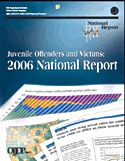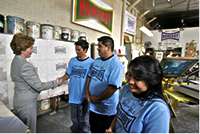
Printer-Friendly Version (July/August 2006) L.A.'s Homeboy Industries Intervenes With Gang-Involved Youth
Through its Gang Reduction Program (GRP), OJJDP supports a number of local gang prevention and intervention programs. One such program is Homeboy Industries, which is partnering with the GRP demonstration site in Los Angeles, CA. An example of successful federal and local coordination, Homeboy Industries receives funds from the City of Los Angeles, Office of the Mayor, the GRP grantee, to continue and strengthen its youth gang intervention services. The Boyle Heights neighborhood in which Homeboy operates is one of four GRP locations around the country. GRP funds community efforts to develop an integrated strategy to reduce youth gang crime through five areas of focus: primary prevention, secondary prevention, intervention, suppression, and reentry. First Lady Laura Bush visited Homeboy Industries in April 2005 as part of her Helping America's Youth Initiative (see photo). The guiding principle of Homeboy Industries' Jobs For a Future project is both purposeful and pragmatic: "Nothing stops a bullet like a job." Located in the gang-afflicted East L.A. community of Boyle Heights, Homeboy Industries offers gang-involved and at-risk youth the opportunity to become productive members of society through a variety of employment-centered services. Father Gregory Boyle, a Jesuit priest, founded Homeboy Industries. Father Boyle believes that "If young people are employed, they're much more likely to lead happy lives because they can be productive and constructive." Homeboy's many programs manifest his words. Youth not only receive access to numerous free services—tattoo removal, counseling, job referrals, and life-skills training—but are able to work (with pay) in the program's several businesses, which include silk-screening, maintenance, and food service (a Mexican-food café and a soon-to-be opened bakery).
Homeboy Industries is well placed to continue its services within the Boyle Heights community and help many more former gang members to lead law-abiding, productive, and successful lives. In remarks given at the 2005 White House Conference on Helping America's Youth, Father Boyle relayed the story of his meeting with one young man who was helped by the program. The youth, named Carlos, was recently released from prison. Covered in tattoos and having a criminal record, he couldn't find a job. Father Boyle set him to work in Homeboy's silk-screening factory. Father Boyle asked Carlos how it felt to work just days after he began. "It feels proper…I'm holdin' my head up high," he said. For more information about Homeboy Industries, visit http://www.homeboy-industries.org. For more information about the Helping America's Youth Initiative, read the feature article "HAY Initiative Promotes Positive Youth Development" in the May/June 2006 issue of OJJDP News @ a Glance. Conference Highlights New Research on Child Advocacy Center Effectiveness Regina B. Schofield, Assistant Attorney General, Office of Justice Programs, addressed the opening plenary luncheon of the National Children's Alliance (NCA) 2006 leadership conference, held May 21-24 in Washington, DC. Designed for leaders in the Children's Advocacy Center (CAC) movement, the conference drew attendees from 46 states. NCA, an OJJDP grantee, is a nonprofit organization that promotes a coordinated, comprehensive response to child abuse and supports the efforts of more than 600 CACs throughout the Nation. CACs are community-based programs that bring together professionals and agencies in multidisciplinary teams that take a child-focused approach to investigating abuse cases and responding to the needs of victims. The goal of the CAC network is to ensure that children are not revictimized by the system intended to protect them. NCA's annual conference provides CAC leaders with education, networking, and advocacy opportunities. Attendees at the 2006 conference learned about two recent studies that document how CACs are helping children and providing cost savings to communities (see "CAC Research Highlights"). In her remarks, Assistant Attorney General Schofield observed: "These are important studies, because they validate the tremendous contributions of child advocacy centers to the welfare of our children." For more information about NCA, visit www.nca-online.org.
The number of youth courts in our Nation is soaring. In 1994, there were fewer than 80 youth courts. Today, that number has grown to more than 1,100 in 49 states, the District of Columbia, and Puerto Rico. In recognition of these unique courts and the dedicated youth and adult volunteers who participate in them, OJJDP, the National Highway Traffic Safety Administration, and the Office of Safe and Drug-Free Schools will celebrate the 5th Annual National Youth Court Month in September. The theme is "Correcting Crooked Paths: Youth and Communities in Partnership for Justice." Also known as teen, peer, or student courts, youth courts offer an adjudicatory venue in which nonviolent juvenile offenders are sentenced by their peers. Youth courts can turn negative events in youths' lives into positive ones by holding youth accountable for their actions and helping them to straighten out their mistakes by giving back to the community through community service. According to OJJDP Administrator J. Robert Flores, "In youth court, young respondents learn that there are consequences for their misbehavior and that their peers are willing to take the time to ensure that those consequences are just. The community benefits by giving young respondents a chance to turn their lives around while educating youth volunteers about the value of participation in our justice system." National Seminar On September 13-15, 2006, in Albany, NY, the National Youth Court Center will conduct the training seminar "Developing and Implementing Youth Courts." Funded by OJJDP, the National Highway Traffic Safety Administration, and the Office of Safe and Drug-Free Schools, this interactive event will enable participants to gain a better understanding of the principles and practices of youth courts, learn how to implement a youth court in their jurisdiction, and network with other professionals interested in establishing youth courts. Administrator Flores will address the seminar. For More Information For more information about youth courts, visit the National Youth Court Center Web site: www.youthcourt.net. The Web site includes the 2006 National Youth Court Month Action Kit, developed to assist youth courts in planning, conducting, and promoting community projects and activities to be held during National Youth Court Month. Drug Court Training Conference Promotes Successful Partnering for Recovery The National Association of Drug Court Professionals held its annual drug court training conference, "Successful Partnering for Recovery," on June 22-24, 2006, in Seattle, WA. Topics included family dependency courts, drug-endangered children, driving while intoxicated, federal drug courts, and cultural proficiency. The June 21 preconference session focused on juvenile justice programs and juvenile drug courts. Marilyn Roberts, OJJDP Deputy Administrator for Programs, organized and presented at this session. The Office of Justice Programs' Drug Court Discretionary Grant Program provides financial and technical assistance to states, state courts, local courts, units of local government, and Indian tribal governments to develop and implement treatment drug courts that effectively integrate substance abuse treatment, mandatory drug testing, sanctions and incentives, and transitional services in a judicially supervised court setting with jurisdiction over nonviolent, substance-abusing offenders. OJJDP oversees the juvenile and family drug court programs. Drug courts seek to halt the revolving door of substance abuse and arrest by linking substance abusing offenders to drug treatment and rigorous judicial monitoring. They bring together judges, prosecutors, defense attorneys, treatment providers, educators, law enforcement, community services, and court staff in a collaborative effort to enforce compliance with court orders. Drug courts also use a system of graduated rewards and sanctions to help substance abusers attain—and maintain—a drug-free life. As a result of growing evidence that drug courts have reduced substance abuse and recidivism, more than 1,160 drug courts have been implemented located in all 50 states. For more information about drug courts, visit the Web sites of the National Drug Court Institute.
MentorYouth.com National Training Seminar On September 24–27, 2006, in New Orleans, LA, the National Network of Youth Ministries, the U.S. Department of Justice, and the Corporation for National and Community Service, will host Mobilizing New Mentors…Through Faith- and Community-Based Collaborations. Speakers will include J. Robert Flores, Administrator, Office of Juvenile Justice and Delinquency Prevention; David Eisner, Chief Executive Officer, Corporation for National and Community Service; Harry Wilson, Associate Commissioner, Administration on Children, Youth, and Families; and Doug Tegner, Executive Director, National Network of Youth Ministries. The registration deadline is September 14, 2006.To access further information about this national training seminar and register online, visit http://www.mentoryouth.com/trainingpromo/. 11th Annual DMC Conference OJJDP's 11th annual conference on disproportionate minority contact (DMC) will take place September 7-10, 2006, in New Orleans, LA. The conference theme is "Law Enforcement Solutions for Reducing Racial Disparities and Disproportionate Minority Contact in Juvenile Justice."Presented through a grant to the Coalition for Juvenile Justice, the September conference is designed to expand partnerships among state juvenile justice advisory groups, state juvenile justice agencies, local juvenile justice practitioners, and law enforcement officers seeking ways to reduce racial disparities and disproportionately high rates of juvenile justice system contact for minority youth. The conference will focus on law enforcement officers' first points of contact with at-risk and offending youth and on the challenges states face in addressing the federal core protection on DMC.
For more information about the conference, visit www.juvjustice.org/conferences/index_conference.html
All OJJDP publications may be viewed and downloaded at ojjdp.ncjrs.gov/publications. Print publications may also be ordered from the Juvenile Justice Clearinghouse (order online at puborder.ncjrs.gov or call 800-851-3420). Now Available Juvenile Residential Facility Census 2002: Selected Findings. Presents findings from the 2002 Juvenile Residential Facility Census, including statistics on facilities and offenders by state and facility type; and national data on facility confinement features, overcrowding, suicide and mental health screening, and deaths in custody. (National Report Series Bulletin, June 2006, NCJ 211080) National Youth Gang Survey, 1999-2001. Presents findings from the National Youth Gang Surveys for 1999, 2000, and 2001, with selected earlier trends and preliminary findings for 2002. Topics include the prevalence of youth gangs, the number of jurisdictions with active gangs, the number of gangs and gang members, gang member characteristics, youth gangs and crime, law enforcement responses, and perceptions of the gang problem. (Summary, July 2006, NCJ 209392) Expanded Version of National Report Available Online  Juvenile Offenders and Victims: 2006 National Report, OJJDP's flagship statistical publication, presents the latest available data on juvenile offending and victimization and the activities of the juvenile justice system, including law enforcement agencies, courts, and corrections. This comprehensive, reliable report compiles data from a variety of sources and presents a wide range of information in hundreds of easy-to-read tables, graphs, and maps—all accompanied by analysis in clear, nontechnical language. The report's chapters mirror the topical organization of OJJDP's online Statistical Briefing Book.
Juvenile Offenders and Victims: 2006 National Report, OJJDP's flagship statistical publication, presents the latest available data on juvenile offending and victimization and the activities of the juvenile justice system, including law enforcement agencies, courts, and corrections. This comprehensive, reliable report compiles data from a variety of sources and presents a wide range of information in hundreds of easy-to-read tables, graphs, and maps—all accompanied by analysis in clear, nontechnical language. The report's chapters mirror the topical organization of OJJDP's online Statistical Briefing Book.
To enhance the utility of the 2006 National Report, OJJDP and the National Center for Juvenile Justice have created an expanded online version in the Briefing Book. This user-friendly online resource presents the full report and individual chapters in PDF format, together with the following special features:
News From the Coordinating Council on Juvenile Justice and Delinquency Prevention The Coordinating Council on Juvenile Justice and Delinquency Prevention is an independent body within the executive branch of the federal government. The Council's primary functions are to coordinate federal juvenile delinquency prevention programs, federal programs and activities that detain or care for unaccompanied juveniles, and federal programs relating to missing and exploited children. The Council is discussing the prospect of cohosting a symposium which will bring together public and private agencies that have experience working with localities through community development efforts. The purpose of the symposium is three fold: 1) to share lessons on funding and assisting systems change/comprehensive community efforts; 2) to establish a database of technical assistance providers and/or systems change initiatives; and 3) to establish a mechanism for coordinating technical assistance to leverage assistance provided local jurisdictions by multiple funders.
The next Council meeting is scheduled for September 8, 2006. For meeting summaries, information about the Council's mission, and links to related resources, visit the Council's Web site at juvenilecouncil.gov.
The Federal Advisory Committee on Juvenile Justice is a consultative body established by the Juvenile Justice and Delinquency Prevention Act of 2002 and supported by OJJDP. Composed of representatives nominated by the Governors, the Committee advises the President and Congress on matters related to juvenile justice, evaluates the progress and accomplishments of juvenile justice activities and projects, and advises the OJJDP Administrator on the work of OJJDP. The next meeting of the Federal Advisory Committee on Juvenile Justice (FACJJ) will be held on October 23-34, 2006, in Columbia SC. The Committee will review drafts of the 2006 Reports to the President and Congress and to the OJJDP Administrator. Observers are invited to open sessions only. Individuals who wish to attend as observers must preregister by October 17, 2006. Go to http://www.facjj.org/meetings.html for details and to see an agenda, when it becomes available. Meeting summaries and other information about the Advisory Committee are available on the Committee's Web site.
OJJDP Welcomes Summer Interns Each summer, OJJDP adds a few individuals and a great deal of youthful enthusiasm. The Office's summer intern program pairs college students with OJJDP staff who serve as mentors. For the interns, it is an opportunity to gain some real world experience in the field of juvenile justice. This year, the Office welcomed eight interns from all over the United States:
Brendan, a Senior at Pepperdine, is representative of the interns' passion and commitment to making a difference in the lives of our Nation's youth. "Community-based problems demand community-sponsored solutions," believes Brendan. "Hundreds, if not thousands, of local solutions exist to local problems in juvenile justice today." With Dorothy Burgess, a Juvenile Intervention Specialist with the nonprofit organization Kansas Legal Services, Brendan is the co-founder of just one such local solution in Wichita, KS. The Step UP program teaches at-risk youth how to secure employment. "Beginning with a half-day seminar, we taught the youth every step required to gain a job, from talking to the manager to filling out applications and knowing when to call back. We supplemented skills training with group exercises asking each teen to brainstorm their individual talents and abilities." Brendan, who initiated another Step UP program in Los Angeles County, CA, has big plans for the future. "Step UP aims to reach more than 500 kids during the 2006-2007 school year in Los Angeles and beyond. Our purpose is to relate the skills, actions, and attitudes necessary to gain meaningful employment and to plan for tomorrow while living purposefully today. We and other community organizations will continue to fulfill our purposes, for we know that there are many teens who have not yet discovered their talents. We must help them." |
||||||||||||||||||||||||||||||||||||
OJJDP Home | About
OJJDP | E-News | Topics | Funding | Programs
State Contacts | Publications | Statistics | Events |
||||||||||||||||||||||||||||||||||||

 For many of the former gang members in the program, this is their first real job. Receiving a paycheck and developing meaningful skills count as tangible benefits of the program, but it is the intangibles—altered perspectives and fresh hopes—that truly change the lives of the participants.
For many of the former gang members in the program, this is their first real job. Receiving a paycheck and developing meaningful skills count as tangible benefits of the program, but it is the intangibles—altered perspectives and fresh hopes—that truly change the lives of the participants.